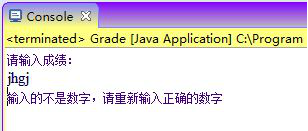异常处理
一、请阅读并运行AboutException.java示例,然后通过后面的几页PPT了解Java中实现异常处理的基础知识
import javax.swing.*;
class AboutException {
public static void main(String[] a)
{
int i=1, j=0, k;
//double i=1, j=0, k;
k=i/j;
//System.out.println(k);
try
{
k = i/j; // Causes division-by-zero exception
//throw new Exception("Hello.Exception!");
}
catch ( ArithmeticException e)
{
System.out.println("被0除. "+ e.getMessage());
}
catch (Exception e)
{
if (e instanceof ArithmeticException)
System.out.println("被0除");
else
{
System.out.println(e.getMessage());
}
}
finally
{
JOptionPane.showConfirmDialog(null,"OK");
}
}
}
结果:

Java中实现异常处理的基础知识:
异常的对象有两个来源,一是Java运行时环境自动抛出系统生成的异常,而不管你是否愿意捕获和处理,它总要被抛出!比如除数为0的异常。二是程序员自己抛出的异常,这个异常可以是程序员自己定义的,也可以是Java语言中定义的,用throw 关键字抛出异常,这种异常常用来向调用者汇报异常的一些信息。
异常是针对方法来说的,抛出、声明抛出、捕获和处理异常都是在方法中进行的。
Java异常处理通过5个关键字try、catch、throw、throws、finally进行管理。基本过程是用try语句块包住要监视的语句,如果在try语句块内出现异常,则异常会被抛出,你的代码在catch语句块中可以捕获到这个异常并做处理;还有以部分系统生成的异常在Java运行时自动抛出。你也可以通过throws关键字在方法上声明该方法要抛出异常,然后在方法内部通过throw抛出异常对象。finally语句块会在方法执行return之前执行,一般结构如下:
try{
程序代码
}catch(异常类型1 异常的变量名1){
程序代码
}catch(异常类型2 异常的变量名2){
程序代码
}finally{
程序代码
}
二、阅读以下代码(CatchWho.java),写出程序运行结果
public class CatchWho {
public static void main(String[] args) {
try {
try {
throw new ArrayIndexOutOfBoundsException();
}
catch(ArrayIndexOutOfBoundsException e) {
System.out.println( "ArrayIndexOutOfBoundsException" + "/内层try-catch");
}
throw new ArithmeticException();
}
catch(ArithmeticException e) { //算数
System.out.println("发生ArithmeticException");
}
catch(ArrayIndexOutOfBoundsException e) { //越界
System.out.println( "ArrayIndexOutOfBoundsException" + "/外层try-catch");
}
}
}
结果:

三、写出CatchWho2.java程序运行的结果
public class CatchWho2 {
public static void main(String[] args) {
try {
try {
throw new ArrayIndexOutOfBoundsException();
}
catch(ArithmeticException e) {
System.out.println( "ArrayIndexOutOfBoundsException" + "/内层try-catch");
}
throw new ArithmeticException();
}
catch(ArithmeticException e) {
System.out.println("发生ArithmeticException");
}
catch(ArrayIndexOutOfBoundsException e) {
System.out.println( "ArrayIndexOutOfBoundsException" + "/外层try-catch");
}
}
}
结果:

四、请先阅读 EmbedFinally.java示例,再运行它,观察其输出并进行总结
public class EmbededFinally {
public static void main(String args[]) {
int result;
try {
System.out.println("in Level 1");
try {
System.out.println("in Level 2");
// result=100/0; //Level 2
try {
System.out.println("in Level 3");
result=100/0; //Level 3
}
catch (Exception e) {
System.out.println("Level 3:" + e.getClass().toString());
}
finally {
System.out.println("In Level 3 finally");
}
// result=100/0; //Level 2
}
catch (Exception e) {
System.out.println("Level 2:" + e.getClass().toString());
}
finally {
System.out.println("In Level 2 finally");
}
// result = 100 / 0; //level 1
}
catch (Exception e) {
System.out.println("Level 1:" + e.getClass().toString());
}
finally {
System.out.println("In Level 1 finally");
}
}
}
结果:

当有多层嵌套的finally时,异常在不同的层次抛出 ,在不同的位置抛出,可能会导致不同的finally语句块执行顺序。
finally语句块不一定会执行。
请看SystemExitAndFinally.java示例
public class SystemExitAndFinally {
public static void main(String[] args)
{
try{
System.out.println("in main");
throw new Exception("Exception is thrown in main");
//System.exit(0);
}
catch(Exception e)
{
System.out.println(e.getMessage());
System.exit(0);
}
finally
{
System.out.println("in finally");
}
}
}
结果:

当程序中出现异常时,JVM会依据方法调用顺序依次查找有关的错误处理程序。
可使用printStackTrace 和 getMessage方法了解异常发生的情况:
printStackTrace:打印方法调用堆栈。
每个Throwable类的对象都有一个getMessage方法,它返回一个字串,这个字串是在Exception构造函数中传入的,通常让这一字串包含特定异常的相关信息。
请通过 PrintExpressionStack.java示例掌握上述内容。依据对本讲多个示例程序的分析,请自行归纳总结出Java多层嵌套异常处理的基本流程。
// UsingExceptions.java
// Demonstrating the getMessage and printStackTrace
// methods inherited into all exception classes.
public class PrintExceptionStack {
public static void main( String args[] )
{
try {
method1();
}
catch ( Exception e ) {
System.err.println( e.getMessage() + " " );
e.printStackTrace();
}
}
public static void method1() throws Exception
{
method2();
}
public static void method2() throws Exception
{
method3();
}
public static void method3() throws Exception
{
throw new Exception( "Exception thrown in method3" );
}
}
结果:

五、一个方法可以声明抛出多个异常
int g(float h) throws OneException,TwoException
{ …… }
ThrowMultiExceptionsDemo.java示例展示了相关特性。
注意一个Java异常处理中的一个比较独特的地方:

import java.io.*;
public class ThrowMultiExceptionsDemo {
public static void main(String[] args)
{
try {
throwsTest();
}
catch(IOException e) {
System.out.println("捕捉异常");
}
}
private static void throwsTest() throws ArithmeticException,IOException {
System.out.println("这只是一个测试");
// 程序处理过程假设发生异常
throw new IOException();
//throw new ArithmeticException();
}
}
结果:

一个子类的throws子句抛出的异常,不能是其基类同名方法抛出的异常对象的父类。
OverrideThrows.java示例展示了Java的这个语法特性。
import java.io.*;
public class OverrideThrows
{
public void test()throws IOException
{
FileInputStream fis = new FileInputStream("a.txt");
}
}
class Sub extends OverrideThrows
{
//如果test方法声明抛出了比父类方法更大的异常,比如Exception
//则代码将无法编译……
public void test() throws FileNotFoundException
{
//...
}
}
六、编写一个程序,此程序在运行时要求用户输入一个 整数,代表某门课的考试成绩,程序接着给出“不及格”、“及格”、“中”、“良”、“优”的结论
要求程序必须具备足够的健壮性,不管用户输入什 么样的内容,都不会崩溃。
import java.util.Scanner;
public class Grade {
public static void main(String[] args) throws NumberFormatException {
double score;
try{
Scanner in=new Scanner(System.in);
System.out.println("请输入成绩:");
score=in.nextDouble();
if((score>=0)&&(score<60)){
System.out.println("不及格");
}
else if((score>=60)&&(score<70)){
System.out.println("及格");
}
else if((score>=70)&&(score<80)){
System.out.println("中");
}
else if((score>=80)&&(score<90)){
System.out.println("良");
}
else if((score>=90)&&(score<=100)){
System.out.println("优");
}
else if(score<0||score>100)
System.out.println("输入数字过大或过小");
else
throw new Exception();
}
catch(Exception e){
System.out.println("输入的不是数字,请重新输入正确的数字");
}
}
}
结果:

